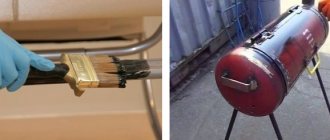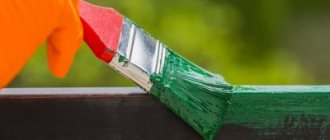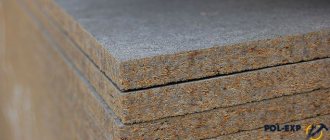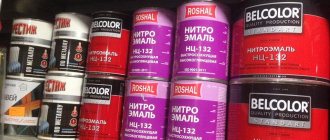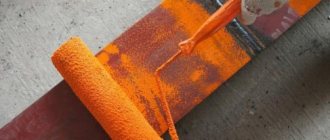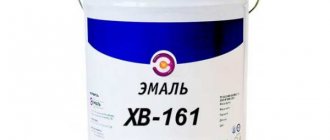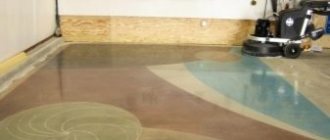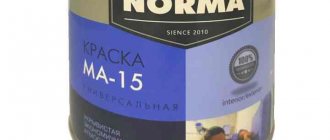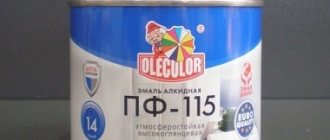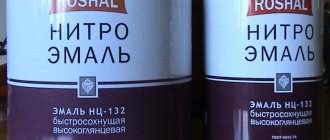Novbytkhim: safety
Work with Novbytkhim paint is carried out at fairly comfortable temperatures - +5-+30°C Novbytkhim enamel is intended for painting floors inside residential buildings. It does not contain volatile particles harmful to health.
The polyurethane base and mineral additives give the paint high mechanical properties. A concrete floor painted with Novbytkhim enamel is able to withstand mechanical loads, exposure to fuels and lubricants, and saline solutions. The paint is available in five color shades - from burgundy to blue. The composition does not tolerate temperature changes well. Therefore, for the floors of a constantly opened garage, it is better to use the more expensive Texil paint. Work with Novbytkhim paint is carried out at fairly comfortable temperatures – +5-+30°C. Before painting begins, the concrete floor must be dried and cleaned. Before use, the paint must be diluted with xylene. The manufacturer recommends using solvents produced by Novbytkhim specifically for this paint. The work is carried out using rollers, brushes, and sprayers. The composition is applied in two or three layers, the interval between staining should be 3 hours - this time is enough for the film to stop sticking. Complete polymerization occurs after 100 hours.
The price of paint varies depending on the packaging: 1 liter in a three-liter container costs about 3.5 conventional units, and in a 20-liter jar - up to 3.
Properties and characteristics
To treat 1 m2 of surface with one layer, 150 - 180 g are needed, depending on the color. After applying the composition, the surface becomes smooth, uniform and shiny, without foreign inclusions.
Main technical characteristics of enamel:
- Viscosity in the range from 70 to 100 sec (at a temperature of 20 °C).
- The degree of periter is no more than 40%. We are talking about an indicator that characterizes the size of the largest particles in pigmented paints and varnishes.
- Drying time is approximately 24 hours (assuming the temperature fluctuates within 20 °C).
- Abrasion resistance - 0.25 kg/µm.
- Elasticity when bending - 1 mm.
- Coating gloss - 57%.
- Adhesion of the composition with other materials - 1 point.
- Retains properties at temperatures from -40 to +60 °C.
The coating successfully resists moisture and can withstand significant mechanical loads.
Analogs of material PF-115
| Enamel PF-133 |
PF-133 enamels are intended for painting freight rolling stock (except refrigerated cars), containers and other metal and wooden surfaces
| Varnish PF-170 |
Varnish PF-170 is a solution of pentaphthalic resin in organic solvents, modified with semi-drying vegetable oil with the addition of a drier.
| Varnish PF-283 |
Varnish PF-283 is intended for application to wooden and metal surfaces to obtain a high-gloss decorative coating
| Enamel PF-218 |
PF-218 enamel is a suspension of pigments, fillers and fire retardant in pentaphthalic varnish with the addition of solvents.
| Enamel PF-266 |
PF-266 enamel is intended for coating painted and unpainted floors.
| Enamel PF-1217 |
Enamel PF-1217 is a suspension of pigments in an alkyd varnish solution with the introduction of additives that give the coating specific properties (fillers, driers, etc.).
Material consumption:
0.08–0.13 kg/m²
Solvent:
solvent, white spirit, turpentine or a mixture thereof in a 1:1 ratio
Color:
Kinds
Today you can find a huge number of enamels on the windows of construction stores. Any enamel is a combination of varnish, coloring pigment and special filler. Such mixtures can be made either water-based or based on organic solvents.
Based on the composition of varnish, enamel is divided into three types:
- alkyd;
- polyurethane;
- acrylic.
Alkyd enamel is considered waterproof and very durable. In addition, she is not afraid of frequent temperature changes. The product is suitable for covering floors in a wide variety of spaces. It is for the design of floors that craftsmen advise purchasing enamels PF 226 and PF 266. These compositions are quick-drying. To dilute them, special white alcohol is most often used, which can be easily found in hardware stores.
Polyurethane enamels are suitable for painting almost any surface because they have very strong adhesion properties to materials. Such enamels can be applied even to a damp surface. They are most often used in public institutions, factories and industrial areas, where it is necessary to create the highest quality and durable floor covering.
Another option is acrylic semi-gloss enamel. It is considered quite resistant to various negative influences from the outside. In addition, it can be used to cover both wooden and concrete floors. This mixture can be called universal; in addition, it does not have an unpleasant odor and dries quickly. The product is excellent for updating floors in residential buildings.
Purpose of paint, how to use it correctly
Oil paint PF-115 is suitable for painting stone and brick surfaces, metal structures, wood, concrete, plaster (cement).
Despite the fact that the maximum operating temperature of the enamel reaches +60°C, you should not paint the roof (slate or tin covering).
Severe overheating of the roof will destroy the paint, it will quickly crack and fade.
The paint layer on a hot battery dries too quickly, volatile substances evaporate, and the enamel falls off in pieces. To prevent this from happening, apply the solution to a disconnected, completely cooled radiator.
The optimal temperature for applying enamel is +5°C.
When decorating outdoors, it will be better if all structures are located in shaded areas. To protect parts from rust, mold or other damage, it is recommended to add special antifungal additives to the paint.
The peculiarity of PF-115 paint is that you can apply several layers of the same color to a structure and get a shade that will differ from the original sample, but the solution will remain the same elastic if one layer was applied.
After drying, parts painted according to the rules will easily withstand the temperature.
This does not apply to the roof, because a constant temperature pressure will be exerted on the roof.
Methods of using enamel
For painting, use a medium hair roller or a paint brush. Spraying the enamel using a spray gun is allowed.
After preliminary preparation of PF-266 and the base to be treated, you can begin painting. To apply the composition, use a paint brush or roller with medium bristles. The spray method can be used. Basically two layers are applied. To obtain a more reliable coating in the required places, it is advisable to treat the surface three times. In this case, the drying period may exceed one day.
After completing the work, you need to put your tools in order. The roller or brush must be cleaned of any remaining enamel. To do this, use a solvent, vegetable oil, and a dry cloth. The container with unused composition should be tightly covered with a lid so that it retains its qualities. Avoid moisture or sunlight penetration.
Coloring rules
In order for PF 266 paint to create an attractive and durable protective film, you must adhere to the following step-by-step steps:
The surface is being prepared. Any contaminants are removed from the wood, including grease stains, dust, dirt, and old paints and varnishes. An electric sander can be used. If the wood is new, it is washed with a soap solution, then with ordinary clean water. After washing, the wood must dry completely. PF 266 is prepared. The film is removed from the solution in the container, after which the mixture is thoroughly mixed. You can use a wooden spatula for mixing, and if the container is large, it is advisable to use a special electric mixer for even mixing. If the composition is too thick, white spirit solvent is used for dilution. Its volume should not be more than 10% of the amount of paint and varnish material. For example, 100 grams of white spirit can be added to 1 kg of dye
It is important to mix the paint and solvent thoroughly. The composition is applied using a spray gun, roller or brush. To paint small elements, for example, baseboards and hard-to-reach places, it is better to use a brush, but it is more convenient to treat a large area with a spray or roller
It is necessary to apply slowly, with smooth movements, it is important to avoid sagging, the formation of puddles or drips. When the first layer has dried (about a day), you can begin applying the second layer. If necessary, apply a third coating of PF 266 paint material.
Paint for your home, utility room or garage?
Painting the floor
First of all, you should decide which floor will be painted: in the house, utility room, garage, cellar. Therefore, you should distinguish between at least three main types of paint:
- Acrylic;
- Polyurethane;
- Epoxy primer enamels.
If the coating is wooden, then you will need a paint containing acrylic and alkyds, since these substances can increase the wear resistance of wooden surfaces.
If painting is required in a utility room or on the floor surface where there are metal ceilings, it is best to use polyurethane paint. It will not form bubbles or cracks; this coating will be quite durable.
Purpose of enamel PF-266
The product is used for painting wooden and metal substrates. Can be used for treating both domestic and industrial premises. Universal paint is suitable for all surfaces.
Important! The composition (GOST 6465-76) is used to treat only internal surfaces; this enamel is not suitable for external work.
The emulsion is intended mainly for treating non-residential premises of fairly large sizes. For this reason, manufacturers offer their products in large metal containers (30 - 50 l).
Enamels for finishing concrete floors
Paints can be applied to the surface with a roller or spray gun. All exterior paints offered by the industry allow you to give the concrete surface the necessary aesthetic, physical and hygienic properties. They are divided according to the method of use - for interior and exterior work. Depending on the chemical base, they are divided into four classes of paints: epoxy, polyurethane, acrylic (Quil, Prestige), rubber. Among the polymers offered by the domestic industry, the most famous are Texil, Prestige, Aquapol, Quil. Foreign companies are also well represented on the market.
- Epoxy paint is a proven material that is traditionally used in industrial production. The two-component base gained popularity half a century ago - during the spread of concrete as a building material.
- Rubber paint is a polymer composition that is actively used today for painting walls, roofs, and floors. It is most often used for finishing swimming pools: the rubber surface has good water resistance and an excellent decorative effect.
- Acrylic paints are a relatively new product, which is created on the basis of a polymer resin of the same name using organic solvents. TD Quil paint is suitable for a concrete garage floor. It can be used to cover a concrete floor indoors, on a platform under a canopy, or at an entrance in front of a gate. The film can withstand temperature changes within all climatic zones - from northern to equatorial.
- Polyurethane paint for concrete floors is usually one-component. The well-known manufacturer Krasko offers a Polymerstone composition made on the basis of a highly elastic and durable polymer. The same company produces Texil paint, which has become widespread among finishers.
Manufacturers
Complete drying in just 1 day and the absence of odor allows for quick local repairs of the damaged surface without stopping activity, i.e., isolating a large area around. High water resistance ensures use for painting floors in baths and saunas. Unlike analogues such as Tikkurila Betolux Aqua, Mizar Rezolux Profi-52 enamel has passed state fire certification and can be used in residential buildings for painting stairs and common areas. In addition, Mizar Rezolux Profi-52 does not require protection from frost - the wide operating temperature range is from -15 to +40°C. The price per kilogram of enamel for Mitsar Rezolux Profi-52 is about 270 rubles. Which is almost 3.5 times lower in comparison with Tikkurila Betolux Aqua. So Russian paints are both cheaper than imported ones and have better characteristics.
VGT paint has proven itself well, which is intended for both interior and exterior use.
In addition, this type of finishing material is characterized by high resistance to light, water and precipitation.
The enamel produced by Lakra also received positive reviews. Due to its universal properties and strong adhesion to the surface, the paint is widely used for finishing floors.
To properly paint a cement, concrete or wooden floor, it must first be thoroughly cleaned, degreased and coated with an acrylic primer. The finish can only be applied to dry surfaces.
The enamel produced by “Prestige” and “Tex” also deserves special attention. It is usually chosen for painting wooden floors. Enamel beautifully decorates wood, giving it an unusual texture and relief. In addition, this paint is produced in many shades and dries quickly.
Peculiarities
PF-266 enamel is produced on the basis of alkyd varnish. Its production in our country is regulated by GOST 6465-76.
According to the standard, the composition also includes a coloring pigment, solvent, and mineral fillers. Thanks to this content, a kind of suspension is obtained, which, when applied to wood, provides not only a decorative function, but also protects the surface from the negative effects of the environment, such as moisture. In addition, the surface treated with this product acquires a glossy shine.
PF-266 enamel is designed specifically for wooden surfaces. It is intended for indoor use only. Outdoors, the coating will have a short service life.
Due to the availability of this product, it is often used for painting floors in public buildings, such as gyms, dormitories, and industrial warehouses. Private individuals rarely buy this paint, mainly for painting floors in old wooden houses or in dacha dwellings.
Before using PF-266 enamel, you should familiarize yourself with its technical characteristics:
- This coating forms an even, shiny coating on the surface. The film gloss is at least 50%.
- Enamel makes the surface moisture resistant.
- Resists abrasion well. Here the strength indicator is 0.25 kg/µm.
- It tolerates temperature changes from -40 to +60 degrees. You should not be afraid of destruction of the coating in conditions when the building is not in use and is not heated in winter. Also, the paint can be stored and transported at subzero temperatures. This will not affect the quality of the product and subsequent performance properties.
- At a temperature of +20 degrees, its viscosity is 70-100 s.
- The degree of paint grinding is a maximum of 40%.
- The composition consumption per layer is 80 g/sq.m. m. The number of layers depends on the color of the enamel.
- The paint dries in 24 hours at an ambient temperature of at least 20 degrees. But the floor will become completely ready for the load only after three days. The surface will gain final strength only after 2 weeks. A completely dried film layer has an impact strength of at least 30 cm.
- The elasticity of the layer during bending is 1 mm.
- Adhesion of the paint composition to the surface to be covered corresponds to 1 point.
- Diluted with white spirit.
- The volume of containers into which the composition is poured at production varies. It ranges from 0.9 l to 50 l.
How to calculate the required volume
What paint consumption will be depends largely on the color of the enamel. The average consumption is 80 grams per square meter, with a single layer application, but a minimum of two layers of enamel will be required. And if a light brown color is used, then it is necessary to create a three-layer coating.
It turns out that the correct consumption must be calculated based on the chosen color; for dark brown enamels it is necessary to multiply the area of the room (its square meters) by 160 grams, and if golden or light paint is applied, then it must be multiplied by 240.
It is advisable to purchase the PF 266 composition with a small reserve; it is necessary to round the resulting amount of solution up.
Purpose of the composition
The product is intended for painting metal or wood surfaces. Used in domestic and industrial premises. An important point is that the composition is approved for use only inside buildings. It is not suitable for outdoor use.
PF-266 enamel is suitable for painting previously prepared floor surfaces. Moreover, the base can be previously painted or unpainted. Most often, the composition is used in those rooms where people are periodically, and not constantly. In such situations, paint is a protective composition for the floor, and not its finishing. That is why enamel is most often packaged in large metal cans (30 or 50 liters). Private individuals use this product extremely rarely. It is usually purchased by construction organizations that carry out renovations of public premises (dormitories, locker rooms, and so on).
Colors
PF 266 is produced in a small number of colors. The manufacturer does not offer unusual or bright colors, for example, orange, blue, red or green. There are only a few shades of brown in the color palette, the most popular of which are red-brown and yellow-brown enamel. Also available in golden brown, copper brown and light brown.
FLOOR ENAMEL, alkyd-urethane, quick-drying
Home \ \ PRESTIGE \ Enamels \ Alkyd-urethane quick-drying FLOOR ENAMEL “PRESTIGE”
INCREASED STRENGTH AND FAST DRYING
Scope of application: Designed to cover new and previously painted wooden floors used inside residential, domestic and industrial premises. Composition: Suspension of a mixture of pigments and fillers in a modified alkyd-urethane resin, with the addition of a drier, solvents and various additives for specific purposes. Properties and features: Quick-drying. Glossy. After drying, it forms a durable, abrasion-resistant coating. Forms a surface resistant to oils, water, household detergents and disinfectants. Surface preparation: The working surface must be dry and free of dirt. Remove the peeling old coating and sand the surface; cracks and depressions should be filled. Sand the putty surface, remove sanding dust with a soft cloth and prime it. Clean metal surfaces from rust and scale, degrease with white spirit solvent and prime with alkyd primer (GF-021, GF-0163, etc.). When applying to old pentaphthalic coatings, it is necessary to pre-grind the surface to a matte state with sandpaper. Application and consumption: Available ready for use. Mix thoroughly before use. If necessary, it is possible to dilute with white spirit or solvent, as well as their mixture in a 1:1 ratio. Dilution depends on the application method (brush, roller, spray gun). The approximate consumption for a single-layer coating is 150 g/m2. Consumption may vary depending on the type, condition and structure of the surface. Enamels can be applied in 1-2 layers. Drying time and processing temperature: Painting work is recommended to be carried out at a temperature of +5C – +35C and a relative air humidity of 655%. Avoid drafts and direct sunlight; it is not recommended to apply enamel in high humidity. Drying time at temperature (202)С and relative air humidity no more than 65%: 6 hours. The second layer can be applied after the previous layer has completely dried. Under other conditions, the drying time of the enamel may vary. Cleaning of tools and hands: Immediately after work, rinse hands and tools with white spirit or nefras C4-150/200, wipe dry with a dry rag. Data characterizing the danger of the cargo: Danger sign according to GOST 19433 drawing 3; class, subclass number - 3.3; classification code - 3313; UN serial number - 1263; emergency card number (for transportation by rail) - 305. Storage and transportation: Store in a tightly closed container, in a cool, well-ventilated place away from heating devices, protecting from moisture and direct sunlight, at a temperature not lower than plus 5ºC. Frost-resistant products! Transportation is possible at temperatures down to minus 40ºС. Freezing 5 times is allowed, followed by mandatory thawing and thorough mixing before use. If frozen, keep for 24 hours at room temperature.
Precautionary measures: Contains volatile organic solvents, so personal protective equipment must be used when working. Carry out painting work with supply and exhaust ventilation running.
Use rubber gloves to protect your hands. In case of contact with eyes, rinse immediately with plenty of water and, if necessary, consult a doctor. Keep out of the reach of children! Disposal: Do not pour paint and varnish products into sewers, water bodies, or onto the soil. Dispose of dry containers as household waste. Transfer liquid residues to hazardous substance collection points. Reminder: Do not mix with other paints and varnishes. Shelf life: 24 months from the date of manufacture.
Safety criteria:
The enamel does not contain: - driers, including metals, chemicals of the 1st hazard class, the amount of which in terms of dry residue exceeds 0.5% - lead crown. Supporting documentation:
PROPERTIES
- quick-drying
- increased hardness and shine
- elastic properties against microfractures
- excellent impact resistance
- highest abrasion resistance
- economical solution
Options
The technical characteristics of the suspension are standard for a paint product of this type and comply with GOST requirements.
Properties and description of the enamel composition
The composition of the mixture, in addition to alkyd varnish, includes:
- organic solvent;
- pigment;
- drier – an element that accelerates the drying process;
- coalescents providing film formation;
- thickeners;
- biocides, preservatives and other additives.
Advantages
The main advantage of pf 266 for flooring is the ratio between price and quality. Despite the fact that LKS is a cheap material, its quality indicators are not inferior to expensive compounds.
Pros related to floor paint PF 266:
- final result of glossy coating – 55%;
- dense covering layer;
- pf 266 is resistant to temperature fluctuations (from -10 to +40 g) and ultraviolet radiation;
- resistance to corrosion;
- high level of adhesion;
- elasticity;
- easy application, both with a paint brush and with a spray gun;
- service life 5 years;
- affordable price.
Flaws
Floor enamel PF 266 contains a solvent with a pungent odor. Therefore, when working with this material, painting is carried out only in a well-ventilated area and using protective equipment.
Also, the disadvantages of this material include:
Preparatory operations and features of using PF-115 paint
In order to ensure an even, high-quality paint coating, the surface must be carefully prepared before applying PF-115 enamel. The work is performed in the following sequence:
- Mechanical cleaning. Using special tools and cleaning products, dirt, layers of peeling paint and other contaminants are removed.
- Degreasing is in progress.
- The surface is leveled and completely dried.
Metal structures are treated with fine-grained sandpaper, a rust converter and coated with a primer compatible with pentaphthalic paint (the first number in the marking is 0). As a primer, you can use PF-115 enamel diluted with white spirit. When updating a decorative coating, it is enough to apply one layer of enamel of the same color, provided there are no cracks or blisters. For strength, after the first layer has dried, apply a second one.
Concrete and plastered surfaces must be completely dry. Can be painted without first applying a primer. Due to low vapor permeability, it is necessary to apply anti-mold drugs under the paintwork. To obtain a durable elastic coating on concrete structures, 2-3 layers of paint are required.
Wooden products are sanded. The enamel is applied in two layers. The wood is pre-impregnated with an antiseptic. Porous surfaces are treated with a special alkyd compound. The interval for applying the second layer can be a day. During the process, it is necessary to add solvent to the paint and stir periodically to obtain a homogeneous mass.
How to paint correctly - description of technology
This material can be applied in the traditional way (using a brush and roller) or using sprayers.
The surface processing algorithm is the same in each case. The composition is applied evenly, in one layer. If a roller is used, the paint should be poured into a special tray. Thanks to this, material consumption is reduced and smudges do not form on the treated floor. After applying the first layer, you must take a break for 24 hours. During this period, it is recommended to open the window for ventilation. After the first layer has dried, the second is applied. It takes up to three days for the enamel to completely polymerize. To deepen the color, you can apply a third coat, also waiting at least 24 hours after the last treatment.
It is recommended to apply the paint with smooth movements so that the dried layer acquires a uniform texture. It is more convenient to do this with a spray gun or roller. Narrow spots (zones where the floor meets the wall, etc.) are treated with a brush.
What should be in the paint?
In addition to those listed above, there is a third type that may require painting - a concrete floor. Special compounds are best suited for it; they can be acrylic, water-based, or polyurethane.
The main thing is that the manufacturer indicates on the can that they are suitable for porous concrete surfaces. Epoxy primer enamels are also suitable for this case.
Painting the floor with a roller
The right choice depends on the characteristics of the room where the floor is being painted. Where crowds of people often form and temperature changes are observed, polyurethane enamel is best suited.
When the room is used as storage and there will be minimal movement in it, for example, a pantry, then it is best to use water-based paint. If you apply it to a freshly poured floor, it will acquire a uniform, even color.
In addition, you should pay attention to the composition of the paint. Enamels containing antifungal and antimicrobial components are suitable for wooden floors.
For iron, it will be promising to see anti-corrosion substances in the paint. Of course, any floor must be protected from moisture. This can be easily dealt with by abrasive substances, which are also included in the paint can.
Paints and their solvents
So, what are solvents for, and in what cases should they be used:
- If the paint has thickened and is difficult to apply with a brush or roller.
- When the paint has dried and turned into a monolith, then it needs to be filled with solvent and left closed for several days.
- If the spray gun (see) does not lift the paint and spits it out.
- When the coating needs to be given additional qualities, which will be discussed below.
- If the paint rolls off the surface and does not contact the base.
- Solvents are also used to degrease the surface before painting.
Serebryanka
How to dilute silver for painting?
Aluminum powder, or in common parlance – silver powder, is sold in two types:
- Powder
that needs to be dissolved. - Ready mixture.
The basis for this paint is drying oil, which is made from vegetable oil with the addition of additives. It is the additives that make this material durable and at the same time completely harmless when dried.
But even ready-to-use silver can be very thick, and white spirit or organic xylene is used to dilute it.
Bitumen paints
How to dilute rubber paint, or rather bitumen-based enamel:
- Rubber, like bitumen, are products of petroleum refining, which means that any form of petroleum solvents is suitable for such paints.
- If you try to add any chemical solvent to the mastic, you will be able to observe the coagulation process when the paint begins to thicken and disintegrate into its components.
Acrylic
How to dilute water-based paint?
The answer to this question lies in the name itself - simple water acts as a solvent here. This is what makes acrylic paint so popular; it contains no chemical components, which means it is completely safe and environmentally friendly.
- Another name for this paint is water dispersion. Some unscrupulous manufacturers often play with these names, passing off exactly the same composition as different brands of paint.
- Therefore, the questions of how to dilute water-based paint and how to dilute water-based dispersion paint have one answer - with water and only water.
Oil paints
How can you dilute oil-based enamel paint? The main type of solvent for PF enamel is white spirit, but any other petroleum-based solvent will also work.
It should be noted that modern PF paints contain many additional additives that increase the service life of the coating and improve adhesion. In this regard, enamels are quite amenable to dilution with chemical solvents, but they must be mixed very carefully and in small quantities.
An interesting fact is that depending on how the PF enamel is diluted, its quality characteristics change significantly. To understand all the interaction processes, we present a small table.
Nitro paints
How to dilute nitro-based metallic paint?
All paints with the word “nitro” or the abbreviation NC in their name are chemical and, therefore, dissolved with identical solvents.
NC enamel has several characteristic features that distinguish it from other types of paints:
- Dries quickly even at sub-zero temperatures.
- Creates a thin film on the surface.
- Depending on the fat content of the solvent, the shine and gloss of the paint can be adjusted.
- The price of nitro paints in cans is lower than for PF enamel.
In addition, nitro paints are available in several types:
- Banks.
- Aerosol cans.
- Permanent markers.
This variety is very convenient, since the quick drying of the paint does not allow you to keep the can open for a long time.
You can learn more about the process of working with spray paint by watching the video in this article.
Facade paints
How to dilute façade paint?
It is very difficult to answer this question unambiguously, since this is a general name, and they can consist of different components:
- Acrylic.
- Silicone.
- Polymer.
- Silicate, or liquid glass.
As a rule, each type of facade paint comes with its own solvent, which interacts with the active substance and improves the final quality of the coating. Therefore, in order not to spoil the paint, you need to carefully read the instructions for use, which are on each can.
Enamel and surface preparation
Before using the emulsion for a wooden floor, preliminary work is carried out. They need not only the paint itself, but also the material on which the composition will be applied. The procedure for preparing the enamel:
- After opening the lid, remove the film formed on the surface. This must be done carefully, without leaving hard pieces in the container, otherwise the appearance of the surface will be ruined.
- Mix the composition well, making it homogeneous. It is recommended to perform this operation using a drill with a special attachment.
- Add solvent (if necessary and no more than 10%). This means can be RS-2, turpentine, white spirit.
- Filter the product using regular gauze.
Preparation of the base includes work on its cleaning:
Wash the floor using detergents
Pay special attention to traces of old paint and rust - they need to be removed using special means. Wash the floor again with clean water. Sand the surface, then remove dust. Rinse the floor with water and dry. Now you can apply paint.
Preparing for painting
You need to prepare the surface to be painted and the enamel itself. The preparation of enamel takes place in 4 stages.
Open the lid of the container and carefully remove the formed film on the top layer of paint.
It is important to do this as carefully as possible so as not to leave large particles in the enamel, which will subsequently spoil the appearance of the coating. Mix the paint until it has a homogeneous consistency. It is better to resort to using a drill using a special attachment. If necessary, dilute the enamel with a solvent in the amount of 10% of the total mass
Turpentine, white spirit and RS-2 are used. Strain the paint through ordinary gauze.
Floor preparation consists of cleaning the surface from various contaminants (dirt, dust, grease, rust, old paint);
- Wash the floor with detergents. To get rid of corrosion and old paint, special tools are used. facilities.
- After initial treatment, rinse the floor again.
- A wooden floor should be sanded well with sandpaper, then waste products from the wood should be removed.
- Rinse the floor one last time and dry completely.
- You can start applying enamel.
Precautionary measures
Paints and varnishes emit fumes that are hazardous to human health. Given this fact, when working with them, it is necessary to remember to follow safety rules. You should take care of personal protection - gloves and a respirator.
Floor paint is highly flammable, so do not use it near open flame sources. It should not be applied in close proximity to food storage areas or in rooms where fresh air does not penetrate.
As a result of using PF-266, the treated materials will not only last much longer, but are also pleasing to the eye, which is why the enamel is quite popular among consumers.

